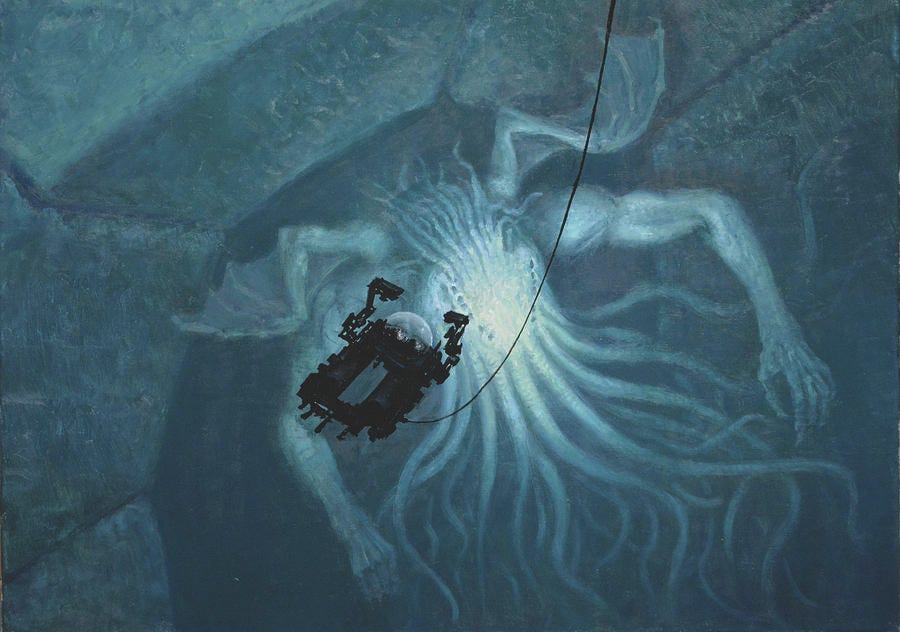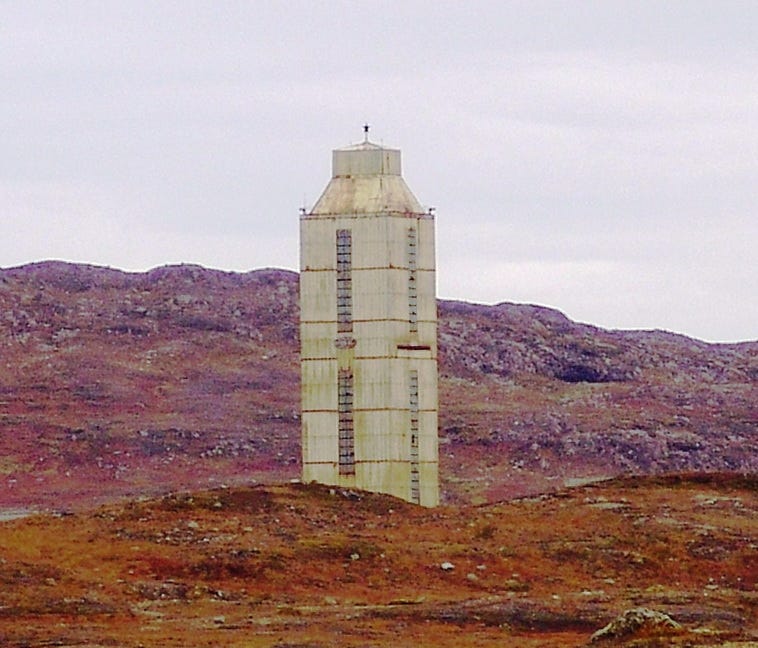From ‘bloops’ to boreholes, sirens to…laser printers? Here are five of my favourite scary sounds from urban legends, and one I found myself in an unexpected place.
1. The Bloop
As a person with extreme thalassophobia (fear of dark water) I had to begin with a scary sound from the deep sea. The ‘Bloop’ was recorded by the U.S National Oceanic and Atmospheric Administration back in 1997. It’s a strange, haunting, ‘ultra-low frequency’ sound for which many explanations have been put forward.
When a huge chunk of ice breaks from the edge of a glacier, in a process known as ‘calving,’ it can cause huge cracking and booming sounds. Perhaps a glacier had calved at just the right moment to be detected by the NOAA. It could have been caused by the grinding of ice along the sea bed. Or perhaps, just perhaps, it could have been the subtle shifting of a gigantic creature stirring in the deep…
Today, when we imagine giant deep sea monsters, we often think of H. P. Lovecraft’s colossal ancient gods like Cthulhu who lived in the submerged city of R'lyeh.
Long before Lovecraft, Japanese storytellers explained the frequent earthquakes in that region (which lies on the large Japan Median Tectonic Line) as the wriggling of a gigantic catfish called ‘Namazu’ who thrashed from time to time when his godly guardian Ebisu fell asleep. To this day the deceptively cute image of a catfish is found on Japanese Earthquake Early Warning devices.
I’ve written before about how the occult, which literally means the ‘hidden,’ is often far more frightening than that which can be seen. Our imaginations are great at filling in gaps with the worst horrors, and sensible horror film directors have often exploited this tendency to keep us imagining as long as possible. Sound has always been one of the most powerful tools for creating this tension, and deep underwater rumblings are a great example of how threateningly suggestive sound can be.
There’s a fun video here which plays The Bloop and a number of other strange underwater noises. Which sounds the most like a giant catfish to you?
Any fellow thalassophobics should check out Iron Lung, a short indie game I reviewed last year. In it, you play as an expendable convict who has been placed in a rickety submarine to explore the dangerous deeps of an alien ocean. The sound of the nightvision camera taking photos of the blackness and then, after a pause, revealing in a grainy image what has just been inches from the window will haunt your dreams.
2. The Borehole
From the depths of the ocean we travel to the depths of the earth. I was doing some research on brutal serial killer tale The House That Jack Built (2018) for another article when I first read about the Kola Superdeep Borehole SG-3 which features towards the end of the film. It appears at a moment when the antihero is trying to escape the police and is led away into a pit which represents the ninth and final circle of Dante’s Inferno. Director Lars von Triers isn’t being subtle here: Jack’s guide is ‘Verge’ just as the poet Dante imagines Virgil leading him through the different levels of hell.
The Kola borehole is 7.619 miles deep. I’ll say that again: 7.619 miles deep. It’s the deepest humans have ever dug, and since its creation it has attracted stories about what had been unleashed. It’s on the Kola Peninsula of Russia, right next to Norway in the North Western part of Russia and the tall grey building that stands in the bleak and barren landscape looks like the world’s loneliest tower block. You’d never guess the marvel of engineering that is hiding underneath.
In the late 80s, reports began to circulate that the Soviets had bored a hole so deep that their microphones had picked up the sound of agonised souls screaming in torment from hell. The proliferation of this urban legend was in part due to American Evangelical suspicion of scientific atheism. Investigating the origins of the myth, Snopes reports:
“In 1989 the Trinity Broadcasting Network (TBN) aired a "Scientists Discover Hell" story and placed the event as happening in the Kola Peninsula. A Norwegian schoolteacher visiting California heard that broadcast and took the story back to Norway with him. He then mailed it to a Christian magazine in Finland. In the form of a letter from a reader, it reached a Finnish missionaries newsletter. From there it returned to the United States, reaching both the TBN people and other evangelists who then claimed they had gotten it from a respected Finnish scientific journal. In the spring of 1990, the legend as we now know it appeared in both Praise The Lord (February) and Midnight Cry (April). Debunkings of it showed up in Christianity Today (July) and Biblical Archaeology Review (November). Even so, the Weekly World News tabloid ran the story in 1992, this time setting it in Alaska and claiming thirteen oil rig workers were killed when the Devil came roaring up out of the ground.” The Well to Hell, Barbara Mikkelson and David Mikkelson (Read full article).
Whatever your religious beliefs, spare a thought for the researcher from Biblical Archaeology Review who was asked to take time out from examining possible evidence for the walls of Jericho to explain that the Russians hadn’t actually dug up Satan in the Arctic Circle.
Some of the ‘well to hell’ audio clips in circulation are thought to be a looped audio sample from the 1972 horror film Baron Blood and I love the idea that sounds recorded for a horror film have aquired their own separate legend. Here is a fascinating video by someone who believes they personally had a near-death experience where they glimpsed hell yet carefully debunks this particular clip:
I wonder whether the ‘well to hell’ audio inspired the scene from sci-fi horror Event Horizon (1997) when horrific snippets of torture and carnage are played, heard at first as audio only. The film is all about humans foolishly opening up a portal to hell, this time by anchoring a spaceship to a black hole where the fabric between realities is thin. It’s still astonishing to me, given how brutal Event Horizon is, that its premise was copied in the Doctor Who episode “The Satan Pit” back in 2006.
And yes, Lord of the Rings fans, all this talk of digging too greedily does indeed remind me of the balrog, a creature unleashed by the unwise mining practices of the dwarves:
“The Dwarves delved deep at that time, seeking beneath Barazinbar for mithril, the metal beyond price that was becoming yearly ever harder to win. Thus they roused from sleep a thing of terror that, flying from Thangorodrim, had lain hidden at the foundations of the earth since the coming of the Host of the West: a Balrog of Morgoth.”
The Return of the King, ‘Durin’s Folk.’
In the 2001 film The Fellowship of the Ring, the sound of the Balrog, which we hear before we see the monster and which scares the orcs away, was made out of cinder blocks scraping across a floor, a kind of geological roar not unlike the underwater groaning of the ice that likely made The Bloop. Paired with the sound of fire, we get the rich and vivid sense that this is not a monster made of flesh. I mentioned Lovecraft earlier but when it comes to the fear of ancient evils lurking in the deep recesses of the world, Tolkien is surely also a crucial voice of the last century. The Lord of the Rings was published 15 years before construction work on the Kola borehole began.
What of the Kola superdeep borehole? The site is now abandoned, and lies in ruins just like the mines of Moria. I expect it’s been a long time since anyone brought a microphone anywhere near it. Perhaps that’s just as well.
Well that’s enough of a deep dive (hehe) for this week, I’ve split this article into two because there was so much to say about each sound. In part 2 we’ll hear much more of the frightening things that scream in the open air.
More Scary Sounds from Readers
Earlier this year, I asked my subscribers what sounds they find scariest. We had a great discussion with a wide range of responses.
pointed to the horror of liminal spaces where distant music seems to be piped in from somewhere, or white noise buzzes as the electric light of empty corridors flickers. told me an absolutely terrifying story of a pipe gurgle that went on for months and turned out to be the toilet (I would have moved house!) told me about the opera called The Listeners which is all about a phenomenon called ‘The Hum’ which apparently only some people can hear. Very relevant to my current horror moments series on horror opera!The ever-knowledgeable
made the great point that films like Irréversible (2002) have used ‘sub-audible’ sounds to ‘create a state of nausea and anxiety,’ sparking a physical response if not a conscious one. This made me think of the sound of a cassowary which you can only hear properly through headphones and is like the growl of a dinosaur in a primordial swamp…Speaking of creatures, lots of people seemed to have had terrifying experiences with animal sounds.
was the winner here, introducing me to something called a ‘Fisher,’ a territorial weasel-like creature which screams and lets out s powerful smell, just like I do when someone wakes me up unexpectedly.If you liked The Bloop,
sent me in the direction of NASA sound scapes recorded in deep space including ‘the bloop of colliding black holes.’Saturn was even creepier, sounding at times like a sigh…
And the Hubble Deep Space puts one in mind of the phrase ‘the music of the spheres:’
What are your scariest sounds? Share below and I might just choose my favourites for next week’s article.
Subscribe for more articles on a range of fascinating subjects. I publish my ‘horror moments’ on Thursdays, and other curious articles like this on Mondays.
Enjoyed this article? Remember that you can pay to subscribe for extra benefits or buy me a coffee here to keep me writing. You can also like, share, comment, and recommend to help the substack grow. Thank you!







Well done! Quite an interesting symphony you’ve collected.
At the risk of echoing the empty vastness: lovely essay.